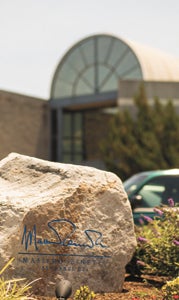Wake up!
Published 11:00 pm Monday, July 21, 2014
Coffee roasters give Suffolk a distinctive aroma
For serious coffee aficionados, there’s nothing quite like the smell of coffee in the morning.
Fortunately for those who live in Suffolk, they can get the scent of a brewing pot as they drive down the Route 58 bypass. Just as they approach the Wilroy Road exit, motorists are treated to the robust odor of coffee wafting from two big coffee roasters — Massimo Zanetti Beverage USA and the J.M. Smucker Co.

The Massimo Zanetti Beverage Company USA facility on Progress Road processes five percent of Americans’ coffee consumption.
Located next door to each other, the friendly competitors receive, clean, roast, blend, grind and package coffee for several well-known brands, as well as private-label and food-service chains.
According to Massimo Zanetti’s Vice President of Manufacturing Ali Itani, the discerning sniffer traveling along Route 58 might be able to tell whether the plant is doing a dark roast or a light roast that day.
But it takes a well-trained nose to tell the difference between Arabica and Robusta beans, or between a blend grown in Mexico and one grown in Hawaii. That job belongs to folks at both plants who “cup” the coffee — testing a brewed cup of each batch for aroma and flavor at various points in the process.
The Massimo Zanetti plant alone receives about seven to eight truckloads per day of green coffee beans from equatorial countries around the world, including the company’s own coffee farms in Hawaii, Brazil and Costa Rica. By the time they’re done with them, the beans have been turned into the equivalent of more than 20 million cups of brewed coffee each day. That’s a remarkable 5 percent of America’s coffee consumption being produced by just one manufacturing plant here in Suffolk.
The beans roasted at Massimo Zanetti have been purchased especially by the company’s commodities team, which is on site at the Suffolk facility to keep an eye on the world’s No. 2 traded commodity, behind oil.
Although many other things happen to the coffee at the Wilroy Road facility, the part of the process that creates the well-known aromas outside the plant is the roasting, according to Massimo Zanetti’s Vice President of Research and Development Charlie Cortellini.
A coffee bean contains one of the most complex sugar structures in the world, with more than 800 volatile molecular species. By comparison, wine has about 150.
As the coffee is roasted, the sugars in the bean are caramelized, and the cell structure “pops,” causing the release of heat from inside the beans. It is this escaping vapor that gives coffee its aroma during the roasting process.
Darker roasts tend to have a stronger aroma than lighter roasts, but light roasts have more flavor, because a dark roast’s flavor “cooks out,” Cortellini said.
It’s little wonder that the Massimo Zanetti roasting process can be smelled clear across town, Itani said. The roasters are nearly three stories high inside the building and can reach 500 degrees, depending on the desired roasting level, color and flavor. Variables such as the weather conditions and altitude at which the beans were grown are also taken into account. They are roasted for a precise amount of time at a precise temperature, and any misstep can ruin an entire batch in a matter of seconds.
“This is why coffee is both a science and an art,” Cortellini said. “It takes great craftsmanship, because the process is so sensitive.”
If the roasting coffee can be smelled so strongly outside the plant, it’s an even stronger aroma for those working directly with the coffee. But employees at Massimo Zanetti don’t mind the aroma, Itani said.
“We don’t hear any complaints,” he said, noting that some employees have been at the plant for more than 25 years. Employees’ favorite days reportedly are the ones when they’re making chocolate hazelnut, French vanilla, peppermint and pumpkin spice, according to Itani.
“The coffee aroma can be very strong and noticeable, but at least the smell is pleasurable, unlike some products can be,” Itani said.
Despite the pleasant aroma, you won’t find a lot of coffee-scented products in the air freshener aisle, Cortellini said. That’s because the coffee scent is produced from such a complex natural process that it’s nearly impossible to replicate artificially.
But that’s not stopping Cortellini from dreaming of an early retirement.
“If I could make an air freshener that smells like coffee, I could rule the world,” he joked.






